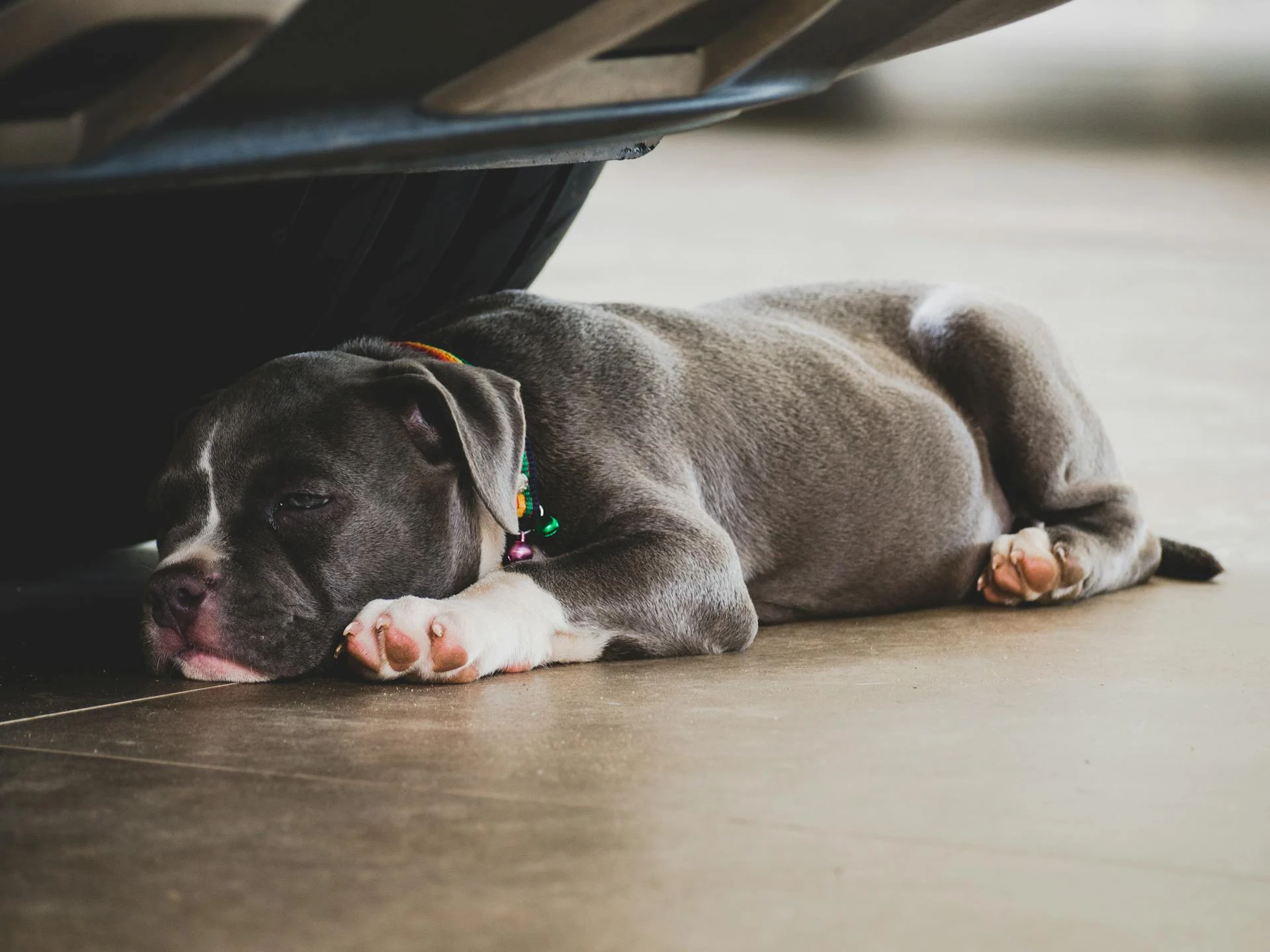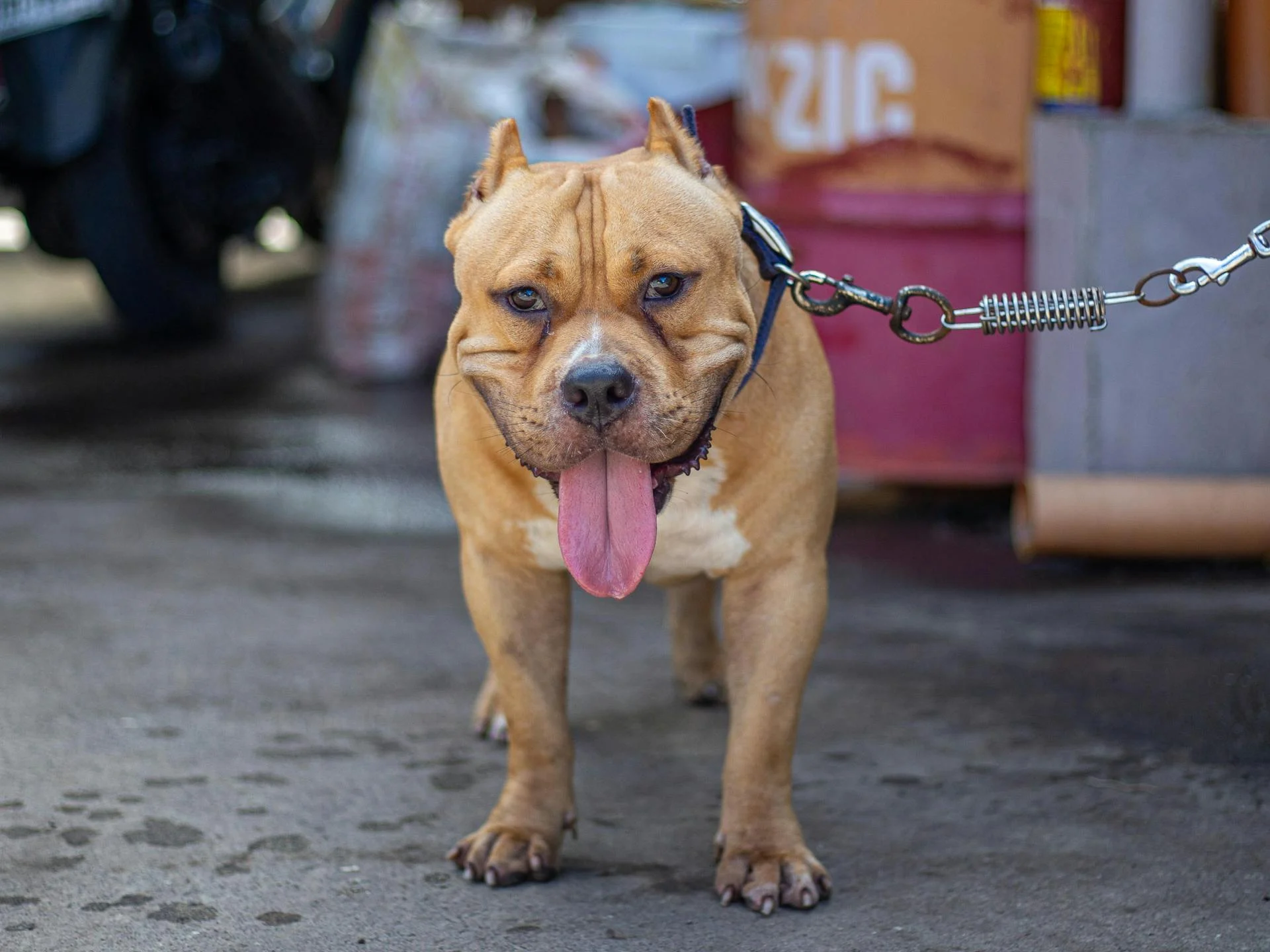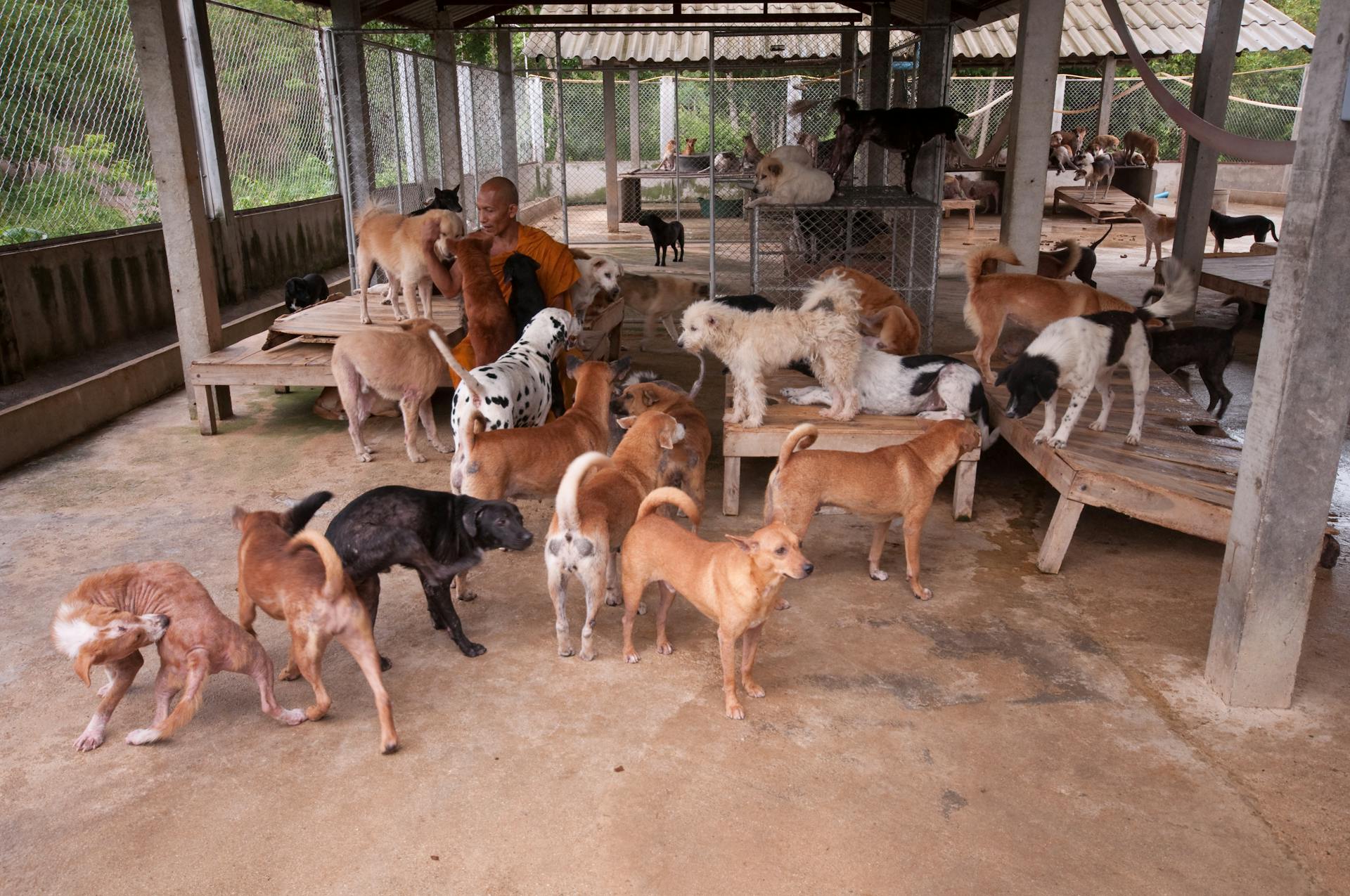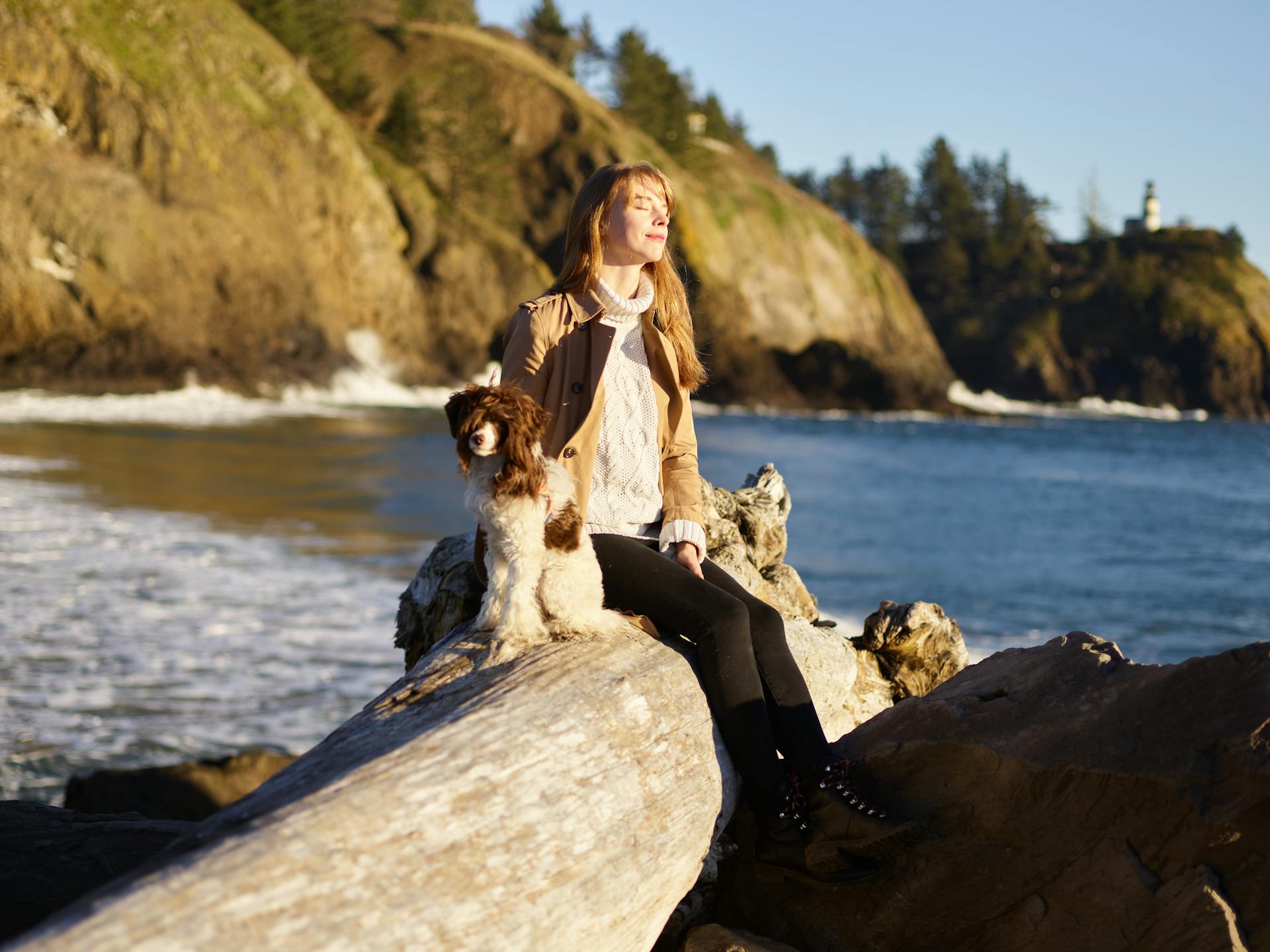
If you're considering bringing a bully breed into your family, it's essential to know the basics. The American Bulldog, for instance, weighs between 70-120 pounds and stands 17-20 inches tall.
These breeds are often misunderstood, but with the right care, they can make wonderful companions. They require regular exercise, such as a 30-minute walk or playtime, to stay happy and healthy.
Their short coats are relatively low maintenance, but they still need regular grooming to prevent skin issues. You can expect to spend around 10-15 minutes a week brushing their coat.
Their strong instincts can sometimes lead to aggression, so proper training and socialization are crucial. With patience and consistency, you can help your bully breed become a well-behaved member of your family.
Consider reading: Dogs Breeds That Start with B
Bully Breeds Chart
The Bully Breeds Chart is a useful tool for anyone looking to learn more about these powerful dogs.
The American Bulldog is one of the most recognizable breeds in the chart, weighing between 70-120 pounds.
These breeds are known for their strength and loyalty, making them popular family pets.
Contents
- The different bloodlines of Bully Breeds
- The various classes of the American Bully
- A comprehensive Bully Breeds chart
We'll be diving into the specifics of each of these topics, so you can get a better understanding of what makes Bully Breeds unique.
Quick Look
The Micro Bully is a compact breed with a unique set of characteristics. It weighs between 30-45 pounds and stands 10-14 inches tall.
This breed has a short, smooth double coat that requires minimal maintenance. Shedding is a common issue, but regular grooming can help manage it.
Micro Bullies are known for their affectionate and sensitive nature, making them great companions for families. They are friendly, social animals that thrive on interaction.
If you're considering getting a Micro Bully for your kids, you'll be pleased to know that they are generally good with children. However, as with any breed, it's essential to socialize them well.
In terms of their relationship with other animals, Micro Bullies can get along with other pets if introduced properly. However, as with any breed, it's crucial to supervise interactions.
Their intelligence level is moderate, which means they can learn with patience and consistency. Training may take some time, but the reward is a well-behaved and loyal companion.
Micro Bullies are relatively low-maintenance when it comes to energy levels, requiring regular exercise but not excessive physical activity. However, they do enjoy playtime and mental stimulation.
One thing to note about Micro Bullies is their tendency to bark occasionally. However, with proper training and socialization, this can be minimized.
On average, Micro Bullies have a relatively short lifespan of 3-8 years. This emphasizes the importance of providing them with a loving and healthy environment.
Readers also liked: Bully Dog Training
Types of Bully Breeds
The term "bully breed" encompasses a surprisingly long list of dog breeds, including the English Bulldog, American Pit Bull Terrier, and French Bulldog.
The American Bully breed has five distinct types: Classic, Standard, XL, Pocket, and Extreme.
The Classic Bully is a leaner, more agile version of the Standard, with a more traditional look. They're great with families, friendly to strangers, and often wonderful with children.
Dog Breeds
The term "bully breed" might conjure up images of English Bulldogs, but it's actually a much broader term that encompasses many other breeds.
One of the most well-known bully breeds is the American Pit Bull Terrier, a favorite among many dog enthusiasts.
The list of bully breeds is actually quite long and includes some breeds that might surprise you.
The French Bulldog is another popular bully breed that's known for its unique appearance and affectionate personality.
Staffordshire Terrier
The Staffordshire Terrier is a breed that's often confused with its cousin, the American Staffordshire Terrier. They're strong and muscular, but a bit shorter in stature.
These dogs have an amazing temperament and are considered one of the most suitable bully breeds for children. They're stocky and muscular, with a confident and good-natured personality.
Staffordshire Terriers are intelligent and enjoy both mental and physical challenges, so they require proper training from their owners. They're not just great with kids, but also make wonderful family pets.
Take a look at this: Staffordshire Bull Terrier Nanny
Mastiff
Mastiff breeds are known for their large size and short muzzles. Some Mastiffs have a fawn or red coat. Bull Mastiffs prefer to be outdoors rather than indoors. They need a firm owner who is very consistent in their training.
You might like: English Mastiff Pictures
Rottweilers
Rottweilers are a popular breed known for their strength and loyalty. They originated in Germany, where they were used for herding livestock and pulling carts.
These dogs are naturally protective and can be aggressive if not properly trained. However, with the right upbringing, they can also be loving and affectionate companions.
Here are some key facts about Rottweilers:
- Average Weight: 45 to 60 pounds (male and female)
- Average Height: 21 to 24 inches (male and female)
- Life Expectancy: 12 to 14 years
Animal Interactions
Micro bullies are generally friendly and social dogs that do well with other animals. They will make an excellent addition to your family if you already have pets at home.
Micro bullies don't have a strong prey drive, making them a great fit for households with small animals like hamsters and rabbits.
Socialization is still necessary to ensure micro bullies grow up to be friendly dogs, so early training and interaction with other pets is crucial.
Additional reading: Corgis as Pets
The 5 Classes
The American Bully breed has five distinct classes: Classic, Standard, XL, Pocket, and Extreme. Each class has its unique characteristics that set it apart from the others.
The Classic Bully has a leaner build, giving it a more traditional look and more agility than the Standard. They're great with their families, friendly to strangers, and generally great with children.
The Standard Bully is similar to the Classic, but with a slightly different build. However, the article doesn't provide specific details about the Standard's characteristics.
The XL Bully, also known as the Extra Large, has a larger build than the Standard and Classic. Unfortunately, the article doesn't provide more information about this class.
The Pocket Bully is a smaller version of the breed, but the article doesn't provide specific details about its characteristics.
Extreme Bullies have higher rear ends and tighter lips than the other lines. They're incredibly muscular and compact, with large skulls.
Additional reading: Brittany Dog Characteristics
Breed Characteristics
The American Bully breed is known for its muscular build and compact body, weighing between 70-120 pounds.
They are often described as gentle and affectionate, making them great family pets.
Their short coats require minimal grooming, but regular nail trimming and ear cleaning are essential.
Their intelligence and loyalty make them highly trainable, but consistency and positive reinforcement are key.
Some individuals can be wary of strangers, so early socialization is crucial to prevent aggression.
Coat Types and Lengths
The coat of a micro bully is quite unique. It's short and smooth to the touch, requiring minimal grooming.
Brushing your micro bully once or twice a week can help reduce shedding and keep their coat healthy. This simple task can make a big difference in their overall appearance.
Micro bullies don't shed much, but they're not a hypoallergenic breed. This means that people with pet allergies may still experience symptoms around them.
What Is Temperament?
The temperament of a micro bully is quite laid-back, making them perfect companions for a relaxing lifestyle. They are lazy dogs that love napping the entire day.
Micro bullies are sensitive dogs that thrive on affection, so they don't take harsh corrections lightly. This means they need to be trained with positive reinforcement techniques.
These gentle souls can get along well with pretty much any furry family member, including dogs, cats, and small animals. However, they may not be able to keep up with active dogs.
Unlike their larger counterparts, micro bullies aren't inherently aggressive and are far from being hostile towards other animals and people. They're sweet companion dogs that always look forward to finding a spot on their owner's lap for cuddles.
Breed Characteristics
Pit Bulls are a general term for several bulldog and terrier mixes, including the American Pit Bull Terrier and Staffordshire Bull Terrier. These breeds are prone to significant variances in their final size.
The American Pit Bull Terrier is estimated to weigh between 25 and 50 pounds at 10 months old, with males weighing more than females. Staffordshire Bull Terriers, on the other hand, tend to be smaller, weighing between 25 and 40 pounds.
Consider reading: Black American Staffordshire
At 6 months old, a female Pit Bull will likely weigh around 15 to 30 pounds, while a male Pit Bull pup will be approximately 20 to 35 pounds. These are just estimates, and your puppy will grow at their own unique rate.
Here's a rough estimate of a Pit Bull's weight at different ages:
A full-grown male American Pit Bull Terrier should ideally weigh between 35 and 60 pounds and stand 18 to 21 inches tall, while a female should weigh closer to 30 to 50 pounds and stand 17 to 20 inches.
Health and Care
As a bully breed owner, you want to ensure your furry friend lives a long and healthy life. Micro bullies, in particular, are prone to joint pain and respiratory problems due to their heavy frame and narrow nostrils.
Joint problems can start as early as their teenage years, so it's essential to keep an eye out for signs of discomfort. Regular exercise and a balanced diet can help maintain their joint health.
Respiratory issues can lead to heat exhaustion and heatstroke, especially in warmer climates. Taking your micro bully for daily walks in cooler parts of the day is crucial to prevent these severe symptoms.
Health Problems

Micro bullies are prone to joint pain and respiratory problems, which can significantly impact their quality of life.
Their body is often too heavy for their frame, leading to elbow dysplasia and severe discomfort, which can start as early as their teenage years.
Respiratory problems are common among short-nosed dog breeds, and micro bullies are no exception, with narrow nostrils and windpipes that cause breathing difficulties.
Heat exhaustion and heatstroke are serious risks for micro bullies, especially in warmer weather, which can lead to severe symptoms like loss of consciousness.
Daily walks in cooler parts of the day and keeping them light and short can help mitigate these risks.
Micro bullies are also at risk for congenital heart disease, allergies, skin problems, cherry eye, and hip dysplasia, which can further compromise their health.
If this caught your attention, see: Short Haired Dog Types
How Long Do They Live?
Micro bullies are prone to developing serious health issues early in their lives, which unfortunately means they don't have a long lifespan.

Their average life expectancy is between three and eight years, which is a relatively short time compared to other breeds.
This means that micro bullies require regular veterinary check-ups and preventative care to manage their health issues and ensure they live a comfortable life.
Their short lifespan also emphasizes the importance of providing them with a loving and stable home environment to make the most of the time you have with them.
Explore further: Puli Dog Short Hair
Ensuring Healthy Gut
A healthy gut is just as important for your Pit Bull as a healthy heart. Regular veterinary exams can help identify any potential issues with your dog's gut health.
Preventative care is always better than treatment, so make sure to schedule regular check-ups with your vet. Routine health exams can help catch any problems early on.
Pit Bulls are prone to allergies, which can cause itchy skin, frequent ear infections, and excessive rubbing of the face. If you notice your pup is licking their paws or showing other signs of allergies, consult with your vet for treatment options.
A balanced diet that includes plenty of fiber can help support your Pit Bull's gut health.
Worth a look: Embark Breed & Health Dog Dna Test Stores
Growth and Development
At 6 months old, a Pit Bull pup will likely weigh between 15 to 35 pounds, depending on whether they're a female or male.
Pit Bulls need around a year to reach their full size, but larger ones may require 18 months to fill out their chest fully.
Female Pit Bulls are slightly smaller than males, and typically weigh between 30 to 50 pounds.
A full-grown Pit Bull, specifically an American Pit Bull Terrier, should ideally weigh between 35 and 60 pounds.
Male Pit Bulls can stand 18 to 21 inches tall at the shoulders, while females stand 17 to 20 inches tall.
Staffordshire Bull Terriers, also referred to as Pit Bulls, are generally smaller and weigh between 24 to 38 pounds.
At 6 months old, a male Pit Bull pup will likely weigh between 20 to 35 pounds.
Pit Bulls come in a range of sizes, but their growth rate is generally consistent, and they typically reach their full size by 1 year old.
Explore further: How Old Do Male Dogs Have to Be to Breed
Responsible Ownership
Responsible ownership is key to preventing aggression in dogs. By starting obedience training early and using positive reinforcement, you can set your dog up for success.
Socialization is just as important as training. Expose your dog to various people, animals, and environments from puppyhood in a controlled manner to help them become confident and calm in new situations.
Bored dogs are more likely to become problematic, so make sure to provide sufficient physical and mental stimulation. This can be as simple as taking your dog for a walk or engaging them in a fun activity.
Supervision is crucial, especially when interacting with children or other animals they don't know well. Don't leave dogs unsupervised in these situations to prevent conflicts.
Here are some key elements of responsible ownership:
- Training: Start obedience training early and focus on socialization.
- Socialization: Expose your dog to various people, animals, and environments from puppyhood.
- Exercise: Provide sufficient physical and mental stimulation to prevent boredom.
- Supervision: Always supervise interactions with children or other animals they don't know well.
Frequently Asked Questions
Which bully dog is best?
For families with children, the Staffordshire Bull Terrier is a great bully breed option due to its gentle and affectionate nature. Its stocky build and short stature make it a sturdy yet compact companion.
What is the smallest bully breed?
The smallest bully breed is the Pocket Bully, a compact version of the American Bully. Recognized by the ABKC, it's a smaller frame of the popular modern dog breed.
What is the lineage of the American Bully?
The American Bully's lineage is a mix of breeds, primarily including the American Pit Bull Terrier, American Staffordshire Terrier, and American Bulldog. Its diverse ancestry also draws from the French Bulldog and Neapolitan Mastiff.
How do you tell what kind of bully you have?
To determine the type of American Bully, look for distinct size differences, such as a lighter body frame in the Classic, and observe the breed's characteristic compact and strong structure. This will help you identify whether your bully is a Pocket, Standard/Classic, or XL.
Featured Images: pexels.com


